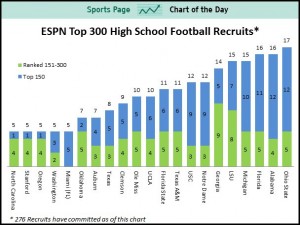NCAA Football fanatics love recruiting signing day! That one day, each year, when you get to find out how good your team will be in 2-3 years. For the past 5 plus years the SEC Conference has been dominating college football’s signing day (as well has the National Championship games!). 2013’s Signing Day was no different. Of the top 300 college football recruits – 41% signed on to play football at a SEC school! (see chart below)
There really isn’t much difference in recruiting a college athlete than there is in recruiting talent to your organization. The SEC dominance in football recruiting, is similar to the dominance that Google has over Yahoo or Facebook. The dominance that Gap might have over similar retailers, etc. If you are being dominated in recruiting by your competition there are some things you can do, and there are some things that will happen naturally to help return balance to the universe. Here’s how I think Big Ten, Pac12, ACC, etc. conference will break up the SEC’s dominance in college football recruiting, and how you can do the same with your organization:
1. Stars want to shine – Great you go offered to go to Alabama, along with 20 other 5 star recruits – it all becomes relative. Recruiters, in non-SEC schools, must sell the ‘opportunity’ for these kids to star right away at their schools. A 5 star kid at Alabama might be a backup for 2-3 years. While at another school they could start as a freshman. Not every recruit will buy into this – but many will. Sell opportunity.
2. The NFL Dream – It says something about you when you’re the 9th best player on your team to NFL scouts. The 9th best NFL player at Alabama might be much better than the best player at Michigan State – the best player at Michigan State is getting more publicity and more NFL scout action than the 9th best player at Bama. The difference might only be 3-5 rounds in the NFL – but that’s huge! Sell the NFL dream that 99% of D1 football recruits have.
3. Stop selling “Michigan Man” – 2nd tier conferences and schools sell this concept of being the right ‘kind’ of person for a school – University of Michigan calls it ‘The Michigan Man’ – we only want kids who are Michigan men, blah, blah, blah. Really!? Well then, I only want to recruit ‘Alabama Men’ because they seem a quite a bit better! If you a recruiter is selling this concept of culture to top level recruits – it might make you feel really good about yourself – but it doesn’t ring true for great talent. Nick Saban doesn’t sell ‘Alabama Men’ – he sells championships. Sell winning, sell being number one in your industry. People love playing/working for a winner.
4. Set Up Shop – Eventually you are going to see Big Ten recruiters actually living, buying a house, etc. full time in SEC territory if they truly want to compete for talent in those areas on a regular basis. Having a local presence, establishing local relationships with high school coaches, etc. says a ton to a player and his family. Flying in once every few months, when Johnny Alabama is there every week, says something completely different. Works the same for your organization – want Silicon Valley talent to come to Tulsa – you better get some feet on the ground!
5. Start Early – You know there are very little recruiting rules in place for kids under the 9th grade! A ‘donor’ for your school could fly in a 8th grader, buy him a sweatsuit and take him to his suite to watch your game – all legal, if under 9th grade. Can you image the impression that makes on a young kid?! Now you might not know if the kid will actually project out to be great – but you get enough interested at a very young age and you begin to get talent you never got before. Long-tail recruiting. This is why campus recruiting is so important to many organizations for talent – you need both a long and short term recruiting strategy to fill your pipeline.
There’s one other thing that will eventually work against the SEC recruiting which seems to happen at all great organizations – laziness. Success doesn’t always breed more success – many times in breeds complacency. The might be the biggest risk of all. The more success they have in recruiting and the more championships they win – the more other recruiters from outside conferences are going to be working harder to get ‘their’ talent. Their great success might be their biggest risk!

